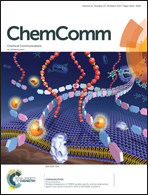The bifunctional catalytic role of water clusters in the formation of acid rain†
Abstract
State-of-the-art chemical bonding analyses show that water clusters have a bifunctional catalytic role in the formation of H2SO4 in acid rain. The embedded H2O monomers mitigate the change in the chemical bonding scenario of the rate-limiting step, reducing thereby the corresponding activation energy in accordance with Hammond's postulate. We expect that the insights given herein will prove useful in the elucidation of the catalytic mechanisms of water in inorganic and organic aqueous chemistry.



 Please wait while we load your content...
Please wait while we load your content...